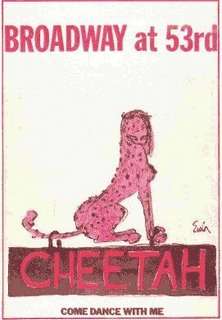Cheetah (nightclub)

Cheetah was a discotheque in Manhattan, New York City which opened May 28, 1966, and closed in the 1970s. The club was located at 53rd Street and Broadway. Robert Hilsky and Russell Hilsky were associated with the club.[1]
According to Steven Watson's Factory Made: Warhol and the Sixties, it "was the granddaddy of the big commercial disco".[2]
| “ |
The most elaborate discotheque was Cheetah, on Broadway and 53rd Street, where everybody, according to Life, looked like "a kook in a Kubla Khanteen." The three thousand colored lightbulbs dimmed and flicked and popped into an infinity of light patterns, reflecting off shiny aluminum sheets. Cheetah held two thousand people and offered not only dancing but a library, a movie room, and color television. "The Cheetah provides the most curious use of the intermedia," wrote Jonas Mekas. "Whereas the Dom shows are restricted (or became restricted) to the In-circle, Cheetah was designed for the masses. An attempt was made to go over the persona, over the ego to reach the impersonal, abstract, universal.[2] |
” |
The musical Hair was performed at Cheetah before becoming a major production on Broadway.[3]
In addition, the Cheetah Club is widely cited as the birthplace of salsa music, or at least of the popular use of the term "salsa" to denote pan-Latin music brewing in New York City. On Thursday, August 26, 1971, the Fania All-Stars headlined the club and drew an overflowing and excited crowd that was later captured on film as Our Latin Thing.[4] The Fania All-Stars brought together the leading lights in Latin music styles (descarga, mambo, boogaloo, merengue, folkloric) and presented a single concert drawing from these diverse influences. Although the term "salsa" had been used in Latin music dating back to at least Pupi Legarreta's 1962 LP Salsa Nova, this modern combination of styles being presented at the Cheetah Club began to become popularly known under the umbrella term "salsa".[5]
References
- ↑ Grunenberg, Cristoph; Harris, Jonathan. Summer of Love: Psychedelic Art, Social Crisis and Counterculture in the 1960s. Liverpool: Liverpool University Press. p. 290. ISBN 9780853239192.
- 1 2 Watson, Steven (2003). Factory Made: Warhol and the Sixties. New York: Pantheon. ISBN 0-679-42372-9.
- ↑ Tharp, Twyla (1993). Push Comes to Shove. New York: Bantam. ISBN 978-0553372649.
- ↑ "Latin Music USA: Chapter 5: Our Latin Thing & the Fania All-Stars", Public Broadcasting Service (PBS) TV documentary, October 2009.
- ↑ Clake, Donald (1989). Penguin Encyclopedia Of Popular Music. London: Penguin. ISBN 0-14-051147-4.
Coordinates: 40°45′48″N 73°58′58″W / 40.7634°N 73.9829°W